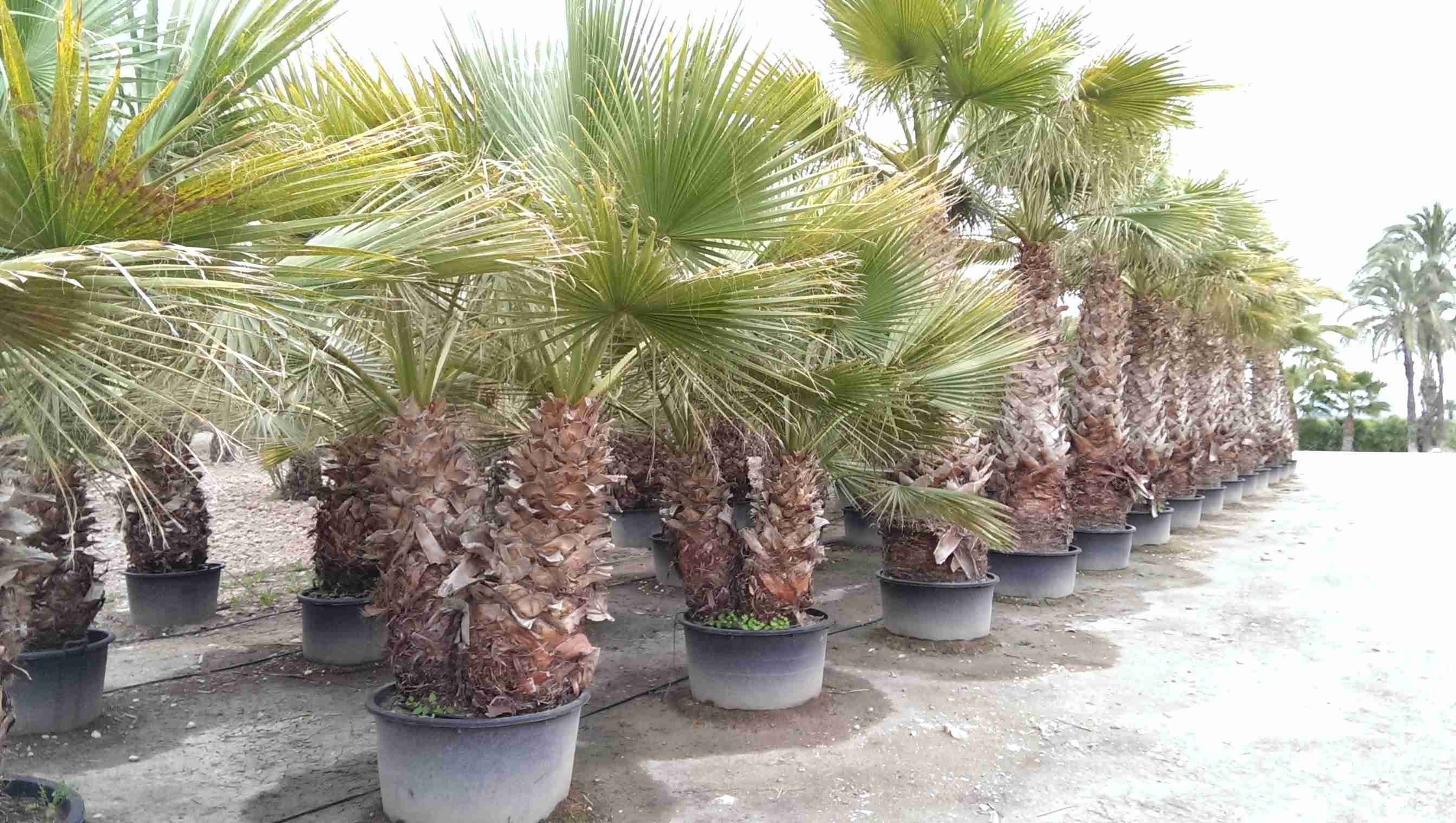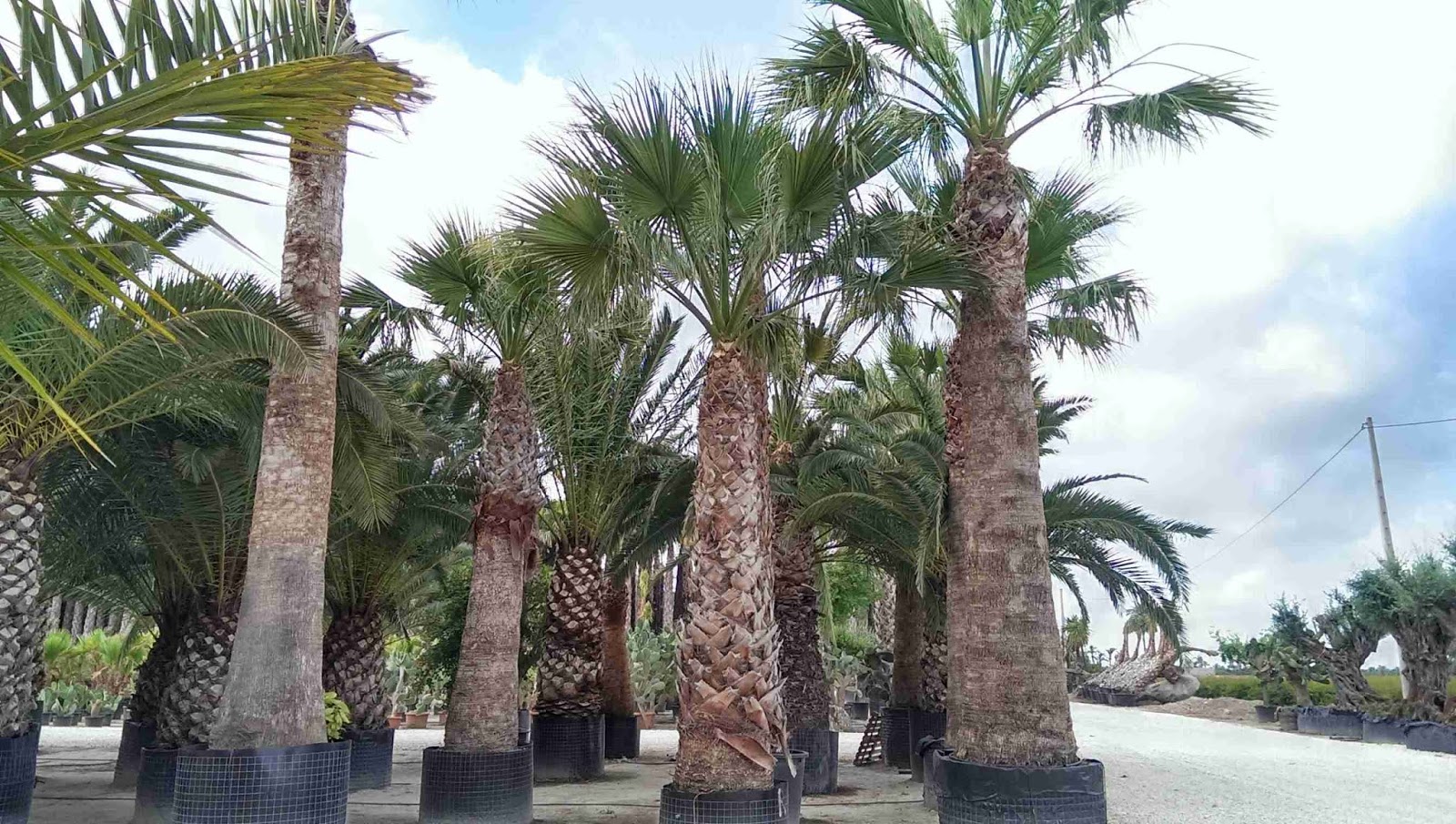Washingtonia filífera Palmera de abanicos Plantas y Jardín

California Fan Palm, Washingtonia filifera, is the only palm tree native to California. It grows in springs in California's southern desserts. California fan palm is hardy to about 10 deg.F. where it grows in the desert. Ours have come back from 15 deg. with no damage. California Fan Palm will eventually be a 50 ft. tree with a study stout trunk.
Ficha de la Washingtonia filifera Plantación de árboles, Palmeras, Árboles y arbustos

Es una de las palmeras más adecuadas para zonas litorales y zonas interiores de clima suave. Es de las especies de palmácea más cultivada en el Mundo. La especie estilizada es la Washingtonia robusta y la de tronco más grueso es la Washingtonia filifera, lo contrario a lo que su nombre de "robusta" podría indicar.
Washingtonia filifera Palmeras y jardines

This hardy tree can be grown in a wide range of soil conditions and is tolerant of salt, making it a great choice for coastal areas. However, it prefers rich, well-draining soils. Neutral to acidic soil pH levels are ideal, but the California fan palm can also tolerate alkaline soil.
Pin page

Description Washingtonia filifera grows to 18 m (59 ft) in height, and occasionally to as much as 25 m (82 ft) in ideal conditions. The California fan palm is also known as the desert fan palm, American cotton palm, and Arizona fan palm.
Tropical Plant Pictures Washingtonia filifera (California Fan Palm)

Washingtonia filifera, also called the desert fan, Arizona fan palm, or California fan palm, is — when it reaches full maturity — a truly majestic plant that positively towers over any desert landscape.The California palm tree belongs to the Arecaceae family, better known as the palm family. Its very small genus, Washingtonia, consists of a few palm species native to California, Arizona.
Palmera Washingtonia Filifera / Washingtonia Robusta Palmera Wasintonia Palmera Sin Picudo

Washingtonia filifera can tolerate a wide range of soil types but prefers well-drained soils. Washingtonia filifera is a drought-tolerant plant, so water it only when the soil is dry. Fertilize Washingtonia filifera every month during the growing season. Washingtonia filifera is a fast-growing plant, so prune it regularly to control its size.
PALMERA DE CALIFORNIA Washingtonia filifera Plantas rioMoros
Desert Fan Palm (Washingtonia filifera) Growing & Care Guide for Gardeners. Article by Dean Ravenscroft, Ph.D. - Updated 16th Oct 2023. Washingtonia Filifera, more commonly known as the Desert Fan Palm, is a flowering Palm plant that mainly grows in the most south-western parts of the United States.. They can easily grow up to 60 feet (18 m) tall and 15 feet (5 m) wide at the crown.
Washingtonia Filifera Palmeras Elche

Height: 40 to 60 feet Spread: 10 to 15 feet Crown uniformity: symmetrical canopy with a regular (or smooth) outline, and individuals have more or less identical crown forms Crown shape: palm; upright Crown density: open Growth rate: medium Texture: coarse 1.
Washingtonia filifera «palmera de California» Id Plantae

Washingtonia filifera showing messy flower spikes (left) and open flowers (right) Washingtonia filifera in full seed. Germination of the ½" seeds is extremely easy and often rapid. Ripe, fertile seed is easy to come by and usually plentiful year round below most adult palms. Seeds are small and slightly ovoid.
20 Washingtonia Filifera Palm Tree Seeds, Rare Mexican Fan Palm Fresh Seeds Mexican fan palm

La Washingtonia de California, 2 ( Washingtonia filifera ), es una especie arbórea de la familia de las Arecáceas. Es, junto con Phoenix canariensis, Phoenix dactylifera y Chamaerops humilis, una de las principales especies de palmera que se utilizan para la jardinería en climas mediterráneos y templados suaves. Detalle de la hoja
Venta de palmeras Washingtonia Filifera

General Information Scientific name: Washingtonia filifera Pronunciation: wosh-ing-TOE-nee-uh fill-LIFF-er-uh Common name(s): Desert Palm, California Washingtonia Palm Family: Arecaceae USDA hardiness zones: 9A through 11 (Fig. 2) Origin: not native to North America Invasive potential: little invasive potential Uses: street without sidewalk; tree lawn 3-4 feet wide; tree lawn 4-6 feet wide.
Washingtonia Filifera Palmeras Elche

The Washingtonia Filifera is more of a dry climate lover than the Washingtonia Robusta and will take temperatures about 8 degrees F lower than the Robusta . They are hardy down to zone 8a in dry winter climates but can have trouble surviving wetter winter climates in these same temperatures and can get root rot.
Washingtonia robusta Palmeras y jardines

Washingtonia filifera Its natural habitat is in valleys and gorges in desert regions. It is notable for being a palm which reaches a great size with a very thick trunk which can, moreover, remain covered by its dead leaves almost indefinitely unless they are pruned away. Its leaves are a greyish green with very thorny petioles.
PALMERA DE CALIFORNIA Washingtonia filifera Plantas rioMoros
Washingtonia filifera (California Fan Palm) is a medium to large evergreen palm with a tree-like growth habit. It has a sturdy columnar trunk crowned by beautifully shaped, fan-like, waxy gray-green blades, up to 3-6 ft. long (90-180 cm). Erect at first, they spread and arch from stout, spiny petioles.
Características y cuidados de la Washingtonia robusta Washingtonia robusta, Mexican fan palm

Washingtonia filifera, also known as desert fan palm, California fan palm or California palm, is a flowering plant in the palm family (Arecaceae) native to the far southwestern United States and Baja California. Growing to 15-20 m (49-66 ft) tall by 3-6 m (10-20 ft) broad, it is an evergreen monocot with a tree-like growth habit. It has a sturdy, columnar trunk and waxy, fan-shaped.
Washingtonia Filifera Palmeras Elche

May 16, 2005. Origin and Habitat: South-western North America (California, Colorado, Nevada, Baja California and in the extreme Northwest of Sonora Mexico). An estimated 25,000 wild desert palm trees exist in the Sonoran Desert. It is naturalized in Florida and the U.S. Virgin Islands.